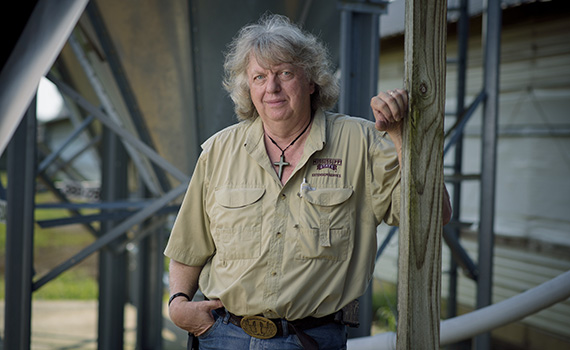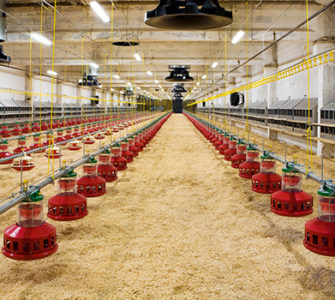Litter problems persist
By Tom Tabler, PhD
Extension Professor
Mississippi State University Extension Service, Poultry Science Department
Mississippi State, MS
Back in 1923, A. B. Dann wrote in Poultry Science that “wet litter in the poultry house is a rather troublesome problem for most poultrymen.”1 I hate to say it, but we have not come very far since 1923. Here we are, almost a century later, and wet litter is still a troublesome problem I often encounter as I make my rounds among growers.
Litter is a combination of bedding material, feathers, wasted feed and manure. Litter is on the floor to absorb water from manure and drinker spillage until it can be removed by adequate ventilation.2 Since birds’ feet are in constant contact with litter, litter quality is directly related to paw quality. Good paw quality is critical to broiler health and performance, and that’s why it’s one of the criteria on animal welfare checklists.
Moisture is a key factor influencing litter quality in broiler houses. We need to reduce the amount of water going into the litter and increase water evaporation.3
How much litter moisture in a broiler house is too much? In truth, there is no single percent moisture content directly associated with the problems wet litter causes. There are also numerous contributors ranging from litter type to bird activity.4
Management is key
Management practices are the key to proper control of litter moisture. Water systems need to be checked regularly and leaks repaired without delay. Drinker height and water pressure should be adjusted appropriately as birds grow to prevent excessive water spillage into litter. In my opinion, drinker height should be adjusted daily, even if it’s just a few clicks on the winch handle.
Increasing ventilation as the flock ages is likewise necessary to meet moisture removal requirements. Ventilation needs to be continually monitored and, as water consumption and manure output increase, must increase accordingly.
Good ventilation is critical at all times of year for litter moisture control. I’ve found that growers often significantly reduce winter ventilation rates to conserve fuel and reduce heating costs, but that in turn often leads to wet litter and increased ammonia levels that threaten flock health. The result is compromised flock welfare, requiring increased ventilation and even more fuel use to get rid of excess moisture, as well as high ammonia levels. In the end, it can cost more than it would have if ventilation rates were maintained at an optimal level to begin with.
Struggles with ventilation
During my years as a broiler service tech, I probably cautioned my growers more about their ventilation program than any other aspect of raising chickens. Little has changed in the last 35 to 40 years because today as a poultry extension specialist, I still find that ventilation is the issue growers struggle with the most.
I didn’t really understand why back in my younger service tech days, but I think I do today. It’s because I can’t show growers ventilation as easily as I can other issues. I can show them feeders that are too high or low or that have too much feed in the pans, resulting in feed wastage. I can show them drinker lines that aren’t at the right height or that need the pressure regulator adjusted. Dirty fan blades or shutters as well as worn fan belts or pulleys are something I can describe and they can easily see.
I can’t show them wind speed, airflow patterns, humidity or ammonia. I could smoke their houses with smoke bombs in between flocks and demonstrate wind speed and airflow patterns, but I can’t do that when birds are present, plus conditions change throughout the time birds are in the house. Unfortunately, things you can’t see are difficult to manage and control.
Factor in bird density
Bird density is another important factor that affects litter moisture. This means timely movement of birds from half- to full-house and uniform bird numbers in both the brood and non-brood ends. Separate water meters for the brood and non-brood ends can help determine when bird numbers are uniform. Or, with practice, it’s possible to accurately “eyeball” each end and determine when numbers are uniform. Once bird numbers are uniform, migration fences should be installed to divide the house into quadrants to maintain uniform flock distribution.
Other measures for moisture control
Use of circulation fans in the ceiling helps dry the litter. They may run continuously or be programed to run whenever the minimum ventilation fans are not running. They should not create a draft, which young chickens don’t like; they should provide gentle air movement, which helps break up air temperature stratification in the house and assists with litter drying.
It’s also important to divert storm water away from the house and pad. Standing water just outside the chicken house can seep into the pad and wick up from the bottom into litter. Floor moisture from the pad or the hardpan — that hard, solid, moisture-laden layer that lies against the pad, if one exists — may play an important role in creating high ammonia levels.
Bedding needs to be sufficiently deep. A minimum of 3 inches should always be maintained. Four to 6 inches appears to be ideal. Litter depth needs to be uniform throughout the house because variability can make it hard to maintain proper feeder and drinker height. Additionally, areas with limited litter will slick over quickly and develop wet spots, leading to higher ammonia levels and increased footpad issues.
Quality litter is about more than just maintaining the proper moisture content. It’s also about friability. When litter is loose and friable, it enables birds to display natural behaviors such as scratching and dust bathing. As litter moisture increases above 25% to 30%, litter begins to get tacky; it starts sticking together and forming clumps or clods because the moisture is acting as a natural binder. Those clumps and clods also threaten footpad health.
Consider water activity
In addition to litter moisture content, I am becoming more convinced we need to consider water activity in litter as well. Moisture content is a measure of how much water is present. Water activity tells us about the energy of that water and how (or if) it can be used by microorganisms.
Water activity is a measure of available or “free” water in the litter. It describes the degree to which water is “bound” in the litter and can help predict the growth of microorganisms because microorganisms can only use “free” water to grow.
A water activity meter is used to measure water activity, which is based on a scale from 0.0 to 1.0. Poultry litter reaches a critical hydration level when the water activity level is between 0.75 and 0.90; that corresponds to a moisture content ranging from 12% to 24%.5 If water activity is kept below the critical hydration point, the litter remains friable and birds can work in manure. When litter isn’t as wet, there should be less growth of microorganisms. Keeping water activity at or below 0.90 — 24% litter moisture — should be the goal.
In general, water activity is greatest with fresh bedding materials and decreases during grow-out with the addition of poultry manure and the natural breakdown of organic materials.6 This happens because bedding materials such as shavings and sawdust are cellulose in nature, and cellulosic materials hold water by simple bonds, whereas adding manure (which contains proteins, carbohydrates and salts) creates more complex molecular bonds that more strongly bind water in the litter.
Good litter management is key to producing healthy broilers and providing proper welfare conditions. This is especially so for broilers produced in a no-antibiotics-ever program. Litter moisture content is a valuable tool for assessing litter quality and determining flock performance, but water activity may be even more important and should receive greater attention in the future since it can affect microbial litter populations.
Editor’s note: The opinions and advice presented in this article belong to the author and, as such, are presented here as points of view, not specific recommendations by Poultry Health Today.
1 Dann, AB. Wet litter in the poultry house. Poult Sci. 1923;3:15-19.
2 Dunlop MW, et al. Water activity of poultry litter: Relationship to moisture content during a grow-out. J Environ Manage. 2016;172:201-206.
3 Liang Y, Tabler GT. Litter management for broiler production. Univ of Arkansas Cooperative Extension Service. Publ No. FSA1098. 2020 December.
4 Dunlop MW. Quantifying poultry litter conditions and relationships with odour emissions. PhD Thesis. University of New South Wales, Australia. 2017.
5 Dunlop MW, et al. Water activity of poultry litter.
6 Ibid.
Posted on July 1, 2021

















